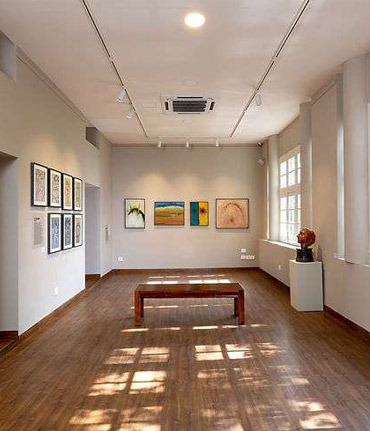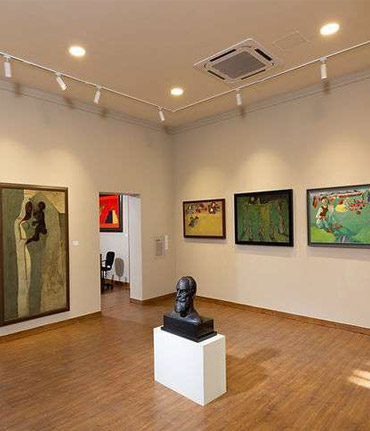Remembering the 'Outliers, Rebels, Disruptors': Dhoomimal Art Gallery and the Delhi Silpi Chakra
"Freedom can only be a political category It cannot be diluted into an advertisement gimmick or a catchy slogan nor can it be a category for elite self-indulgence where freedom is interpreted as license."
— Sadanand Menon
Looking across the history of nations we find that in the event of any major national crisis, art has been one of the mediums responsible for evoking a sense of insurgency and non-conformity among masses. Being enmeshed with socio-political and cultural causes, has it not become almost synonymous with ”freedom“ in the post-1900‘s era?
Being no exception to this struggle for freedom, ndia has been the breeding ground for similar artist led initiatives. Formed in 1949, the Delhi Silpi Chakra was one such example.
Ongoing at Dhoomimal Art Gallery, New Delhi, "Outliers, Rebels, Disruptors: Delhi Silpi Chakra, 70 years on" relooks at the works of the artists involved in the establishment of this collective; artists who went on to significantly influence the trajectory of modern Indian art in the second half of the 20th Century.
Conceptualized and curated by Poonji Nath and Keshav Mahendru FAQ Art and Pramod Kumar KG and Abhay Bhalla of Eka Archiving, the exhibition features the artworks of B.C.Sanyal, Arpita Singh, J. Swaminathan, Satish Gujral, Jaya Appasamy, Sailoz Mookherjea, Ram Kumar, Rameshwar Broota, Amarnath Sehgal, Nand Katyal, K.G.Subramanyan and more. On the occasion of this show we got a chance to converse with the co-founder of FAQ Art, Keshav Mahendru (co-curator of the exhibition) on the making of Delhi Silpi Chakra, their ideologies and activities, the role of Dhoomimal Art Gallery in its establishment and the evolution and the curation of this show that will be on exhibit till 2nd July.
A 'Chakra' in the Making
The elation surrounding the independence of the country was layered with traumas and multiple ruptures that the partition caused in society. People were uprooted from their native lands and compelled to move from Pakistan to India and vice versa, and this included artists, thespians, scholars and writers. The creation of the Delhi Silpi Chakra was considered essential for their sustenance and for the emergence of a cultural identity for a nation in a state of flux.
Reeling from the effect of communal uprisings, 1940's India witnessed the birth of several artist groups, especially in the presidencies of Bombay (Mumbai), Madras, Delhi and Calcutta (Kolkata). Kolkata became the home to the Calcutta Progressive Art Group in 1943, founded by Subho Tagore, Nirode Mazumdar and Rathin Maitra. In Bombay, artists like F.N.Souza, M.F.Husain, K.H.Ara among others formed the Progressive Artists' Group in 1947.
In Delhi, the Delhi Silpi Chakra formed on 25th March, 1949 at the hands of Bhabesh Chandra Sanyal, Pran Nath Mago, K.S.Kulkarni and Dhan Raj Bhagat among other artists. Multigenerational and inclusive, the Chakra sought to create a space for emerging artists and to curate exhibitions in public spaces and refugee neighborhoods. existing institutions in Delhi did not.
Rather than having shared ideologies, the Chakra shared with the Bombay and Calcutta artist groups the desire to make the visual arts more accessible to the masses and create a democratic platform for ideas and culture to flourish. It sought to promote younger artists and create an agency through which their works could be employed for commercial purposes.
Laid down by their manifesto, "Art Illuminates Life" was the motto of the Chakra. It further stated: "The group recognizes that art as an activity must not be divorced from life; that the art of a nation must express the soul of its people and ally with the process of progress.
Ideologies, Art Pedagogies and Exhibitions
Driven towards setting a fresh narrative in the modern Indian art scene, the Silpi Chakra organized discussions, exhibitions and regular training classes. Artists from across the country were invited to participate and facilitate these events.
Commenting on the group's activities to address the post-partition trauma through art, Keshav explains that the experience was formative for many artists like Amar Nath Sehgal and Satish Gujral. While Sehgal initially explored themes of human deprivation and depravity in his sculpture, Gujral captured the anguish of partition and the desperation of refugees. In subsequent decades, as the Nehru administration went through its project of early Punjab Agricultural University, among other important institutions.
Much of the art curriculum of the group was designed by Jagdish Swaminathan. Works by artist members were sold to doctors, lawyers, actors and others. Art lovers who were unable to purchase works were offered paintings of their choice on rent, leading to the broadening of the circle of their patrons.
Extending beyond its functions as a training centre and a commercial platform for artists, the Chakra were also instrumental in propagating discussions in the form of printed questionnaires among visual artists and other multidisciplinary non-members. One such questionnaire was published in 1957 as "Views on Contemporary Art" and circulated among artists, scholars, critics and writers as a means to spark conversation and debate.
Initially gathering at the 7, Jantar Mantar Road, Delhi, the group later moved to B.C.Sanyal's studio 26, Gole Market. Eventually, the group established its permanent premises at 19-F, Shankar Market in January 1957. The Shankar Market address became the gathering space for artists, musicians, writers, poets, dancers, intellectuals and art enthusiasts till the group's dissolution.
Dhoomimal Art Gallery- A Shop turned Art Space
One of the few places that stocked art supplies, Ram Babu Jain's Dhoomimal Dharamdas Stationers was a space for conversations and discussions for the Silpi Chakra artists. Struggling to buy supplies, they frequented Ram Babu's store where he sold them art materials at minimal prices. In exchange artists began gifting some of their works to him.
When B.C. Sanyal was looking for a place to set up an art gallery to exhibit and market the works by the Chakra artists, Ram Babu offered the mezzanine level of his shop. An ally to the flourishing of the Delhi Silpi Chakra, this gallery emerged from the very needs of the artists of Delhi.
As the artists became more occupied with work, the gallery became harder to manage. Sanyal requested Ram Babu to take over the daily running of the gallery and, over time, the Dhoomimal Art Gallery emerged as one of India's oldest galleries.
Curating a Retrospective
The Delhi Silpi Chakra being a long-time enigma, this exhibition was the first of its kind for him since the 1997 NGMA retrospective in Delhi that had attempted to explore this part of art history. Taking us through the curation of the Silpi Chakra show, he says that one of the challenges the curators faced was the inability to put the Chakra into a box like you could for other artistic movements. Besides rebelling against prevailing ideas in art, it was a suggests.
Though the Chakra solely comprised artists, several non-art practitioners frequented the group activities too. Poets and writers like Nirmal Verma, Prayag Shukla; musicians like the Dagar Brothers; art historians and critics such as Charles Fabri, K. B. Goel and Richard Bartholomew also became associated with the collective.
Along with the support of the Dhoomimal Art Gallery, the Delhi Silpi Chakra played a crucial role in transforming the cultural and intellectual landscape of Delhi. Building an atmosphere to inculcate an artistic and intellectual awareness, and a space for a cultural evolution and revolution, the Chakra and the capital's art scene gradually morphed into each other. Initiated by a group of progressive minds who sought to establish their vision of modernity, the Delhi Silpi Chakra celebrated the secularism and plurality of a newly formed nation through their ideology and activities.
References
1. Delhi Silpi Chakra Critical Collective.
2. Menon, Sadanand, "M.F. Hussain: When the Nation Loses Its Own Narrative", Economic and Political Weekly, June 18-24, 201 1, Vol. 46, No. 25, Pg. No. 13-15; Publ. by Economic Political Weekly.
3. Mitter, Partha, "The Triumph of Modernism: India's artists and the avant garde, 7922-7947", Publ. by Reakton Books, (2007).

